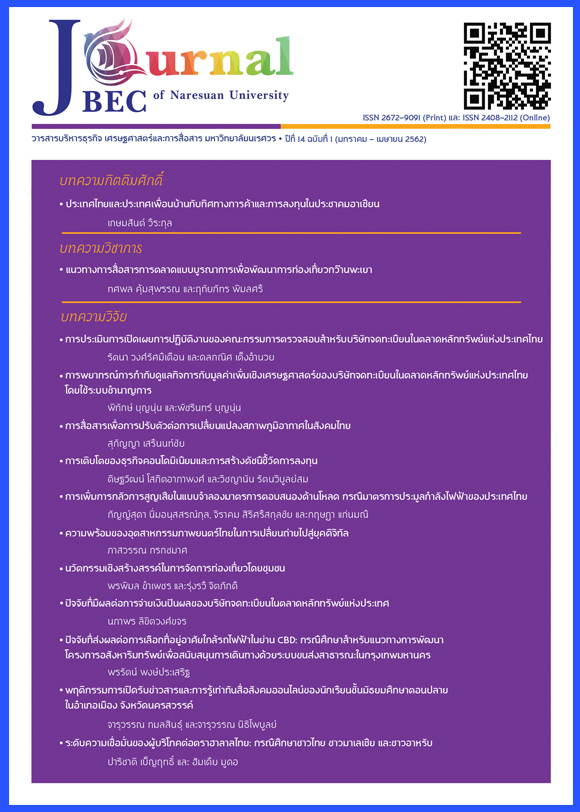การพยากรณ์การกำกับดูแลกิจการกับมูลค่าเพิ่มเชิงเศรษฐศาสตร์ของบริษัทจดทะเบียนในตลาดหลักทรัพย์แห่งประเทศไทยโดยใช้ระบบชำนาญการ
Main Article Content
บทคัดย่อ
การพยากรณ์การกำกับดูแลกิจการกับมูลค่าเพิ่มเชิงเศรษฐศาสตร์ของบริษัทจดทะเบียนในตลาดหลักทรัพย์แห่งประเทศไทยซึ่งใช้ระบบชำนาญการ โดยจัดเก็บข้อมูลจากงบการเงินของบริษัทจดทะเบียนในตลาดหลักทรัพย์ โดยแยกเป็นกลุ่มธุรกิจต่าง ๆ ตามการซื้อขายหลักทรัพย์ ในช่วง ปี 2554-2558 ยกเว้นกลุ่มธุรกิจการเงิน กลุ่มเทคโนโลยี กลุ่มอสังหาริมทรัพย์และก่อสร้าง กลุ่มทรัพยากร และกลุ่มการแพทย์ การพยากรณ์นี้อาศัยการนำเอาระบบที่จัดให้มีโครงสร้าง และกระบวนการที่มีความสัมพันธ์ระหว่างคณะกรรมการฝ่ายจัดการ และผู้ถือหุ้น โดยคำนึงถึงความสามารถในการแข่งขันที่จะนำไปสู่ความเจริญเติบโตที่จะสามารถเพิ่มมูลค่าให้กับผู้ถือหุ้นในระยะยาว และคำนึงถึงผู้มีส่วนได้เสียทุกฝ่ายของกิจการตลอดจนแสดงถึงความสัมพันธ์ถึงมูลค่าเพิ่มเชิงเศรษฐศาสตร์ที่จะสนับสนุนการตัดสินใจสำหรับการลงทุนทางการเงินเพื่อสร้างมูลค่าสูงสุดให้กับผู้ถือหุ้นและมูลค่ากิจการในอนาคต โดยการวิจัยจะทำการวิเคราะห์ตัวแปรทุกตัวแปรที่มีผลเกี่ยวข้องกันกับค่าที่ต้องการพยากรณ์โดยวิธีการทางสถิติ และการพยากรณ์ที่นำมาใช้คือโครงข่ายประสาทเทียมแบบแพร่กลับมาเป็นอัลกอริทึมสำหรับการทำนาย ผลการพยากรณ์โดยใช้โครงข่ายประสาทเทียม โดยกำหนดให้มี 4 อินพุต และ 6 อินพุต โดยในการพยากรณ์ได้กำหนดไว้ว่าหากค่าที่ทำนายได้มีค่าอยู่ในช่วง 0-0.499 ให้คำตอบเป็น 0 และหากค่าที่ได้มีค่าในช่วง 0.5-1.00 ให้คำตอบที่ได้มีค่าเป็น 1.00 ผลที่ได้จากการทดสอบจะได้ค่าความแม่นยำมากกว่าร้อยละ 60 ที่จะนำไปสู่คำตอบที่ต้องการ โดยการทำงานได้มาจากการฝึกสอนข้อมูลในอดีตและพยากรณ์ในช่วงปี 2558 เพื่อดูค่าความแม่นยำ งานวิจัยสามารถพัฒนาเพื่อให้ผลการพยากรณ์มีความแม่นยำมากขึ้นต่อไปในอนาคต
Article Details
References
2. Aman, H. and Nguyen, P. (2008). Do stock prices reflect the corporate governance quality of Japanese firms?. Journal of the Japanese and International Economies, 22(4), 647-662.
3. Amirov, A., Gerget, O., Devjatyh, D. and Gazaliev, A. (2014). Medical data processing system based on neural network and genetic algorithm. Procedia-Social and Behavioral Sciences, 131(May 2014), 149-155.
4. Brown, L. D. and Lee, Y. J. (2010). The relation between corporate governance and CEOs’ equity grants. Journal of Accounting Public Policy, 29(6), 533-558.
5. Jensen, M. C. and Meckling, W. H. (1976). Theory of the firm: Managerial behavior, agency costs and ownership structure. Journal of Financial Economics, 3(4), 305-360.
6. Jones, J. J. (1991). Earning management during import relief investigations. Journal of Accounting Research, 29(2), 193-228.
7. Omoteso, K. (2012). The application of artificial intelligence in auditing: Looking back to the future. Expert Systems with Applications, 39(9), 8490-8495.
8. Saengsai, J. (2017). The impact of business merger to the firm performance on the listed companies in the Stock Exchange in Thailand. Journal of Business, Economics and Communications, 12(1), 137-149.
9. Shan, Y. G. (2015). Value relevance, earnings management and corporate governance in China. Emerging Markets Review, 23(June 2015), 186-207.
10. Sutton, S. G., Holt, M. and Arnold, V. (2016). The reports of my death are greatly exaggerated–Artificial intelligence research in accounting. International Journal of Accounting Information Systems, 22(September 2016), 60-73.
11. Wang, D. (2006). Founding family ownership and earnings quality. Journal of Accounting Research, 44(3), 619-656.
12. Wang, K. T. and Shailer, G. (2017). Family ownership and financial performance relations in emerging markets. International Review of Economics and Finance, 51(September 2017), 82-98.

